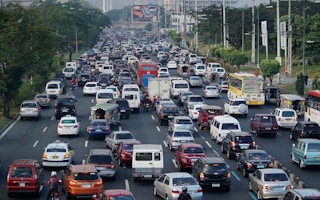Air quality in Metro Manila is returning to its usual noxious levels as Covid-19 lockdown measures are loosened up. But this backslide into business-as-usual can be preempted if local governments adapt existing measures and transition to cleaner energy technologies, a new report says.
Published by the international think tank Centre for Research on Energy and Clean Air (CREA) and Greenpeace Philippines, the new report shows that air pollution has been making a gradual comeback in the Philippine capital since authorities began easing the lockdown beginning May 16.
During lockdown, the city’s notorious air pollution levels dropped, giving residents back a view of the skyline they hadn’t seen in decades. The lifting of the smog also gave a glimpse of what cities can be like with vastly improved air quality, the report says.
The report is the second one released by the group and focuses on Metro Manila, specifically the cities of San Juan, Caloocan, Quezon City, Makati, Marikina, Pasig and Manila. Metro Manila is composed of 16 cities and one municipality. It looks at data on two major air pollutants emitted from burning fossil fuels: nitrogen dioxide (NO2) and fine particulate matter known as PM2.5. Levels of these pollutants were measured by the Sentinel-5 TROPOMI satellite.
Since the beginning of May, NO2 and PM2.5 concentration levels in the atmosphere increased steadily, ahead of starting to loosen lockdown measures.
“The rebound has far-reaching implications for the country’s recovery, as air pollution, particularly from the burning of fossil fuels in transportation and industry, impacts not only health but also climate and the environment,” the report says.
All seven cities covered in the report showed an increase in their NO2 levels at the beginning of May, with Pasig and Makati showing a 75 per cent jump in a week’s time. Unlike NO2 levels, however, PM2.5 levels did not dramatically rebound with the easing of lockdown, as transportation activities within cities remain limited, even as traffic volume on major roads and highways increased, the report says.
The nasty-smelling reactive NO2 gas contributes to the formation of smog and air pollution, while PM2.5 is often a byproduct of NO2; both can cause respiratory problems. Studies have shown that air pollution makes people more vulnerable to Covid-19 infection, which also primarily affects the respiratory system.
“
The rebound has far-reaching implications for the country’s recovery, as air pollution, particularly from the burning of fossil fuels in transportation and industry, impacts not only health but also climate and the environment.
Both NO2 and PM2.5 are linked to severe respiratory and cardiovascular illnesses that can cause premature death. Exposure to high levels of air pollution affects the body’s natural defenses against airborne viruses and increases vulnerability to the current pandemic, the report says.
In February, Greenpeace Southeast Asia and CREA released a report looking at the impact of air pollution from fossil fuels in Southeast Asia. The burning of coal, oil and gas is estimated to cause around 27,000 premature deaths per year in the Philippines and costs the country up to 1.9 per cent of GDP in economic losses annually.
Keeping air pollution at manageable levels is possible, the report says, and cleaner air could reduce additional public health risks. It could also address climate, environmental and economic issues that air pollution magnifies, the report says. To do that, it’s crucial to incorporate the welfare of the urban poor, the segment most vulnerable to dangerous air quality, in the development of solutions, it says.
The return of air pollution to levels seen before the pandemic is expected, the report says, as the Philippines depends heavily on fossil fuels across all sectors. But air pollution can be eased without sacrificing people’s access to mobility if the government learns from the lessons of the lockdown and considers maintaining flexible work arrangements or “staggered work shifts” across sectors. This approach can help control the spread of the virus, save employees from long commutes, and reduce traffic volume on the roads, the report says.
Urban design also plays a key role. The report points to going for a “people-centric” design that makes sustainable use of limited resources for all. Community-based designs, conceptualised in consultation with residents, should support “the physiological, mental and social well-being” of its residents and aligned with mobility programmes.
It’s also important to support existing mass transportation systems and rebuild people’s trust in them by coming out with clear guidelines for safety and sanitation measures. There should be stimulus packages for displaced drivers and transport-related workers, who could be tapped for local government relief and response initiatives.
Lastly, low-cost, active and carbon-neutral transport options should take center stage, and micro-mobility options, like walking and cycling, should be encouraged, the report says.
It adds these efforts should be combined with tighter vehicle emission standards, the development of real-time monitoring capabilities of dangerous pollutants, and strengthened industrial air pollution standards.
Investments in e-mobility projects like funding battery-charging infrastructures for bikes, scooters and e-jeeps should be considered, and both businesses and private citizens should be given incentives to shift, the report says. “Reorganise transport systems with health and wellness as a priority,” it says.
This story was published with permission from Mongabay.com.

















